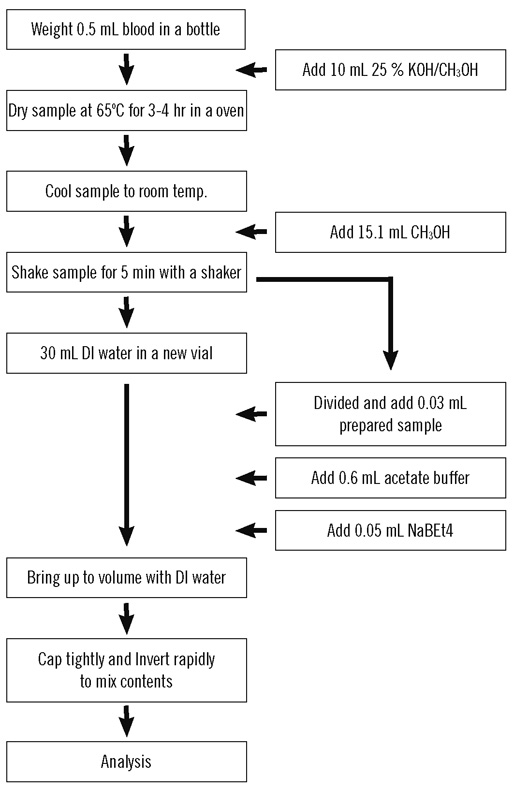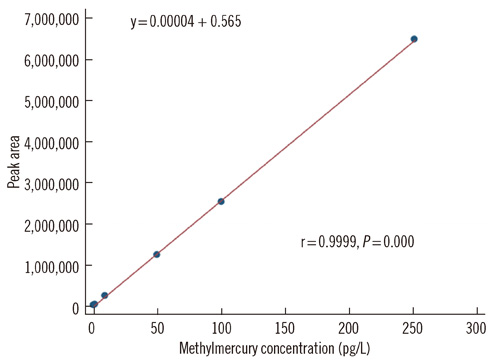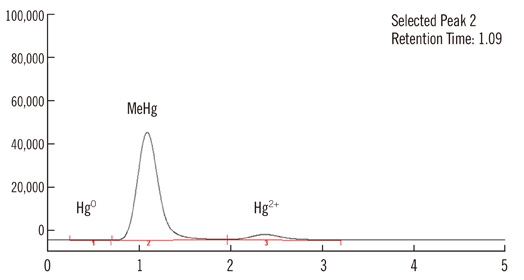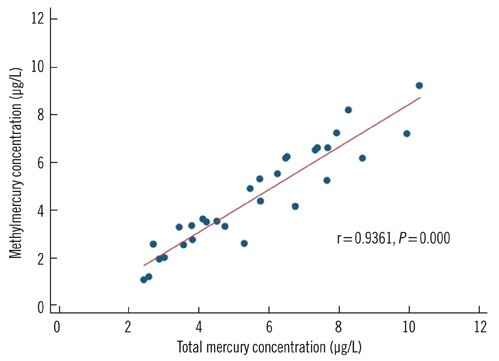Ann Lab Med.
2012 Jan;32(1):31-37. 10.3343/alm.2012.32.1.31.
Analysis of Methylmercury Concentration in the Blood of Koreans by Using Cold Vapor Atomic Fluorescence Spectrophotometry
- Affiliations
-
- 1Department of Preventive Medicine, College of Medicine, Dong-A University, Busan, Korea. yshong@dau.ac.kr
- 2Regional Cardio-cerebrovascular Diseases Center, Dong-A University Medical Center, Busan, Korea.
- 3Department of Environmental Epidemiology, National Institute of Environmental Research, Incheon, Korea.
- 4Department of Occupational & Environmental Medicine, Kangbuk Samsung Hospital, School of Medicine, Sungkyunkwan University, Seoul, Korea.
- KMID: 1781435
- DOI: http://doi.org/10.3343/alm.2012.32.1.31
Abstract
- BACKGROUND
Methylmercury is an organic form of mercury that is highly toxic to humans. Here, we present and establish a novel method to detect methylmercury concentrations in the blood of Koreans.
METHODS
Methylmercury concentration was analyzed with an automated methylmercury analytic system (MERX, Brooks Rand Co., USA) using cold vapor atomic fluorescence spectrophotometry (CVAFS). A variety of biological materials were digested in methanolic potassium hydroxide solution. The analysis method was validated by examination of certified reference material (955c, National Institute of Standard and Technology, USA). We randomly selected 30 Korean adults (age 20 yr or older) to analyze total blood mercury and methylmercury concentrations.
RESULTS
The detection limit and methylmercury recovery rate using this method were 0.1 pg/L and, 99.19% (range: 89.33-104.89%), respectively. The mean blood concentration of methylmercury was 4.54+/-2.15 microg/L (N=30). The mean proportion of methylmercury to the total mercury concentration was 78.27% (range: 41.37-98.80%).
CONCLUSIONS
This study is the first report to analyze blood methylmercury concentration using CVAFS in Korea. We expect that this method will contribute to the evaluation of mercury exposure and the assessment of the toxicological impact of mercury in future studies.
Keyword
MeSH Terms
Figure
Reference
-
1. Navarro M, López H, Sánchez M, López MC. The effect of industrial pollution on mercury levels in water, soil and sludge in the coastal area of Motril, southeast Spain. Arch Environ Contam Toxicol. 1993. 24:11–15.
Article2. Tsuji JS, Williams PR, Edwards MR, Allamneni KP, Kelsh MA, Paustenbach DJ, et al. Evaluation of mercury in urine as an indicator of exposure to low levels of mercury vapor. Environ Health Perspect. 2003. 111:623–630.
Article3. Grandjean P, Weihe P, Nielsen JB. Methylmercury: significance of intrauterine and postnatal exposures. Clin Chem. 1994. 40:1395–1400.
Article4. Risher JF, Murray HE, Prince GR. Organic mercury compounds: human exposure and its relevance to public health. Toxicol Ind Health. 2002. 18:109–160.
Article5. Mason HJ, Hindell P, Williams NR. Biological monitoring and exposure to mercury. Occup Med. 2001. 51:2–11.
Article6. Schoeman K, Bend JR, Koren G. Hair methylmercury: a new indication for therapeutic monitoring. Ther Drug Monit. 2010. 32:289–293.
Article7. Harada M. Minamata disease: methylmercury poisoning in Japan caused by environmental pollution. Crit Rev Toxicol. 1995. 25:1–24.
Article8. Jo EM, Kim BG, Kim YM, Yu SD, You CH, Kim JY, Hong YS. Blood mercury concentration and related factors in an urban coastal area in Korea. J Prev Med Public Health. 2010. 43:377–386.
Article9. Lee JS, Ryu YJ, Park JS, Hong EJ, Kang HK, Jeon SH, et al. A study of analytical method for methylmercury in fish using purge and trap gas chromatograph-mass spectrometer. J Korea Soc Environ Anal. 2007. 10:8–12.10. Kim HY, Chung SY, Sho YS, Oh GS, Park SS, Suh JH, et al. The study on the methylmercury analysis and the monitoring of total mercury and methylmercury in fish. Korean J Food Sci Technol. 2005. 37:882–888.11. Lee JS, Park JS, Kang HG, Cho JS, Hong EJ, Jeong GT, et al. Analysis of mercury and methylmercury in river sediment samples. Anal Sci Technol. 2009. 22:44–50.12. De Wild JF, Olson ML, Olund SD, editors. U.S. Geological Survey Open-File Report 01-445. Determination of methyl mercury by aqueous phase ethylation, followed by gas chromatographic separation with cold vapor atomic fluorescence detection. Updated on Sep 2008. http://pubs.usgs.gov/of/2001/ofr-01-445/.13. Liang L, Bloom NS, Horvat M. Simultaneous determination of mercury speciation in biological materials by GC/CVAFS after ethylation and room-temperature precollection. Clin Chem. 1994. 40:602–607.
Article14. Kingman A, Albertini T, Brown LJ. Mercury concentrations in urine and whole blood associated with amalgam exposure in a US military population. J Dent Res. 1998. 77:461–471.
Article15. Berglund M, Lind B, Björnberg KA, Palm B, Einarsson O, Vahter M. Inter-individual variations of human mercury exposure biomarkers: a cross-sectional assessment. Environ Health. 2005. 4:20.
Article16. Kim GB, Kim DS, Kang TS, Lee JH, Joung YH. Comparison study between total blood mercury and methylmercury. Proceedings of Annual meeting of Korean Society of Health Education and promotion. 2007. 2:345–348.17. Mahaffey KR, Clickner RP, Bodurow CC. Blood organic mercury and dietary mercury intake: National Health and Nutrition Examination Survey, 1999 and 2000. Environ Health Perspect. 2004. 112:562–570.
Article
- Full Text Links
- Actions
-
Cited
- CITED
-
- Close
- Share
- Similar articles
-
- Determination of Lead in Urine by Atomic Absorption Spectrophotometry
- An Analysis of Chrome in Cements and Bleaching Detergents
- Concentrations of lead, iron and zinc in blood of coal workers' pneumoconiosis patients
- Methylmercury Exposure and Health Effects
- Measurement conditions for cadmium in urine by flame atomic absorption spectrophotometry







